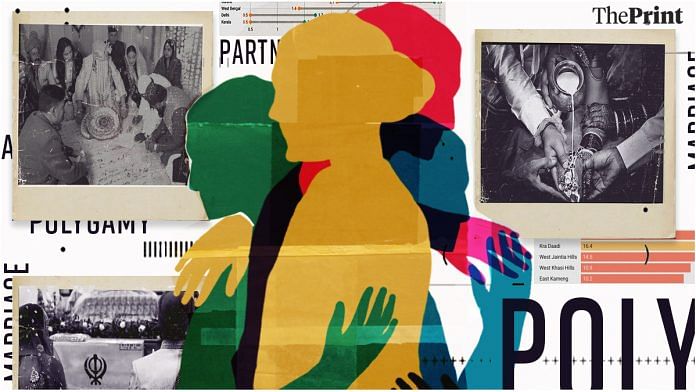New Delhi: Polygamy has entered the political discourse in the past few months owing to speculation over a Uniform Civil Code (UCC), but data shows the practice is rare in India — so much so that only 1.4 per cent of married Indian women surveyed in 2019-2021 said their husbands had another wife or wives.
India has also seen a decline in instances of polygamy across religions and demographies, according to a research brief published by the Mumbai-based International Institute for Population Sciences (IIPS) in June 2022. It makes these assertions on the basis of responses gathered across multiple rounds of the National Family Health Survey (NFHS), up to the latest, NFHS-5 (2019-21).
The brief goes on to highlight that the practice of marriage to more than one spouse at a time is more prevalent among tribal-dominated districts, besides the ‘poorest’ and ‘uneducated’ households. The authors — Harihar Sahoo, R. Nagarajan and Chaitali Mandal — use NFHS-5 data to establish that incidents of polygamy are highest among members of the Scheduled Tribes (ST) in India.
Compared to the national average of 1.4 per cent (NFHS-5), the rate of polygamy was 2.4 among STs, 1.5 among SCs, 1.3 among OBCs and 1.2 among others.
Even among STs, the number has come down from 3.1 per cent in NFHS-3 (2005-06) to 2.8 per cent in NFHS-4 (2015-16) and further to 2.4 per cent in NFHS-5 (2019-21).
“Although polygynous marriage is not legal in India for any community other than Muslims, its practice still continues in some sections of the society in India,” reads the brief. It adds that the “prevalence of polygynous marriages in India was quite low, at 1.4 per cent in 2019-21, and further declined over time”.
The research brief draws on responses to a question on polygamy in the NFHS questionnaire. As part of the nationwide survey, married women were asked whether their husbands had more than one wife.
The percentage of women who responded in the affirmative declined from 1.9 in 2005-06 (NFHS-3) to 1.6 in 2015-16 (NFHS-4) and eventually to 1.4 in 2019-21 (NFHS-5).
In simpler words, in 2005-06, almost one in every 50 women admitted to being in a polygynous marriage. By 2019-21, this number dropped to one in every 70 women. The NFHS-5 also provides data for women who were married between 2015-18, and of those, not even 1 per cent were reported to be in a polygynous marriage.
“Polygynous marriage was more prevalent among women who had no formal education than among those who had higher educational qualifications,” reads the brief.
A polygamous relationship is one in which a person is married to two or more people at the same time, whereas a polygynous relationship refers to a man being married to two or more women at the same time.
Also Read: 82% women in India able to refuse sex to their husbands, finds govt’s family health survey
Decline across religions
The brief further specifies that incidents of polygamy have dropped across followers of most religions considered, namely Hindus, Muslims, Christians and Buddhists, while witnessing a marginal increase in the case of Sikhs — 0.5 in 2019-21 from 0.3 in 2005-06.
India’s Muslim personal law does leave room for polygamy. That is, a Muslim man is allowed to have four wives. However, data shows that the practice is not all that prevalent among Indian Muslims.
According to the NFHS-5 data, only about 1.9 per cent of Muslim women said their husbands had more than one wife, compared to 1.3 per cent of Hindu women who admitted to being in a polygynous marriage in 2019-21.
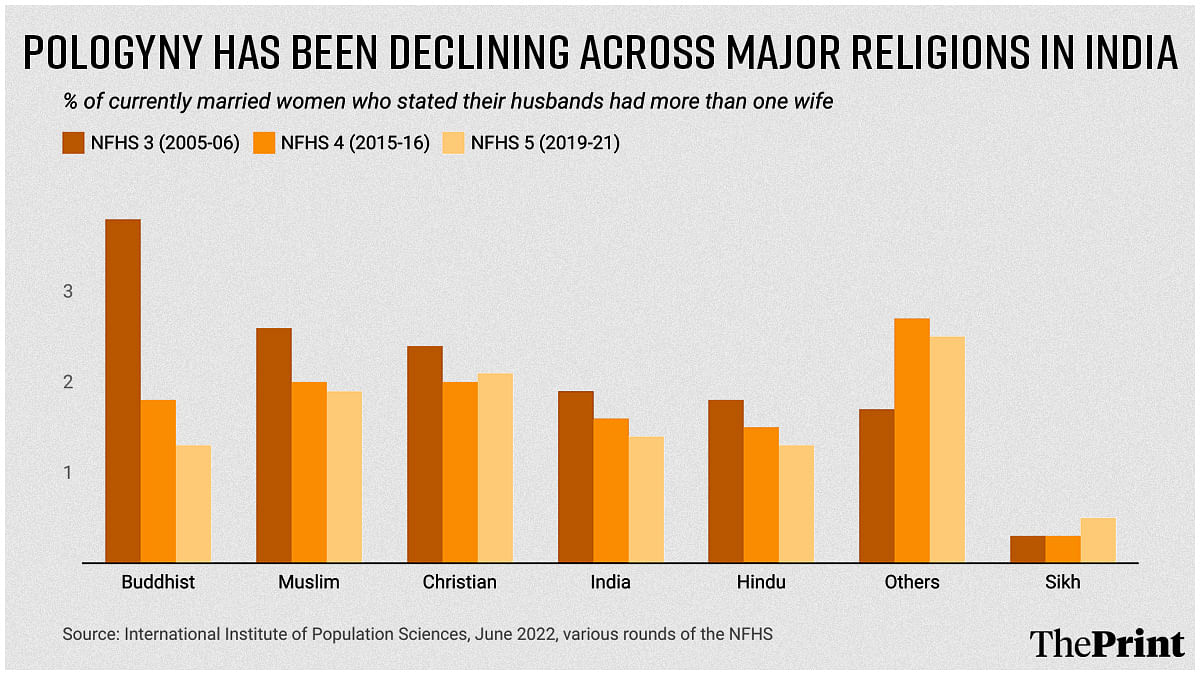
Since the population of Muslim women is at least four-five times lower than that of Hindu women, there is a chance that Hindu women living in polygynous marriages may outnumber Muslim women in absolute terms.
The gap was wider in 2005-06, when 2.6 per cent of Muslim women admitted to living in a polygynous relationship, compared to 1.8 per cent Hindu women.
It is important to note that this gap is also subject to regional heterogeneity.
For instance, Assam — where Chief Minister Himanta Biswa Sarma reportedly said in May last year that a Uniform Civil Code would act as “protection” for “Muslim daughters” — had the widest gap between Hindu and Muslim women who admitted to being in a polygynous relationship in 2019-21. The rate of polygamy among Hindu women in Assam was about 1.8 per cent, according to NFHS-5 data, as against 3.6 per cent among Muslim women.
Other states and Union territories where this gap was wide included Odisha, West Bengal, Delhi, and Kerala.
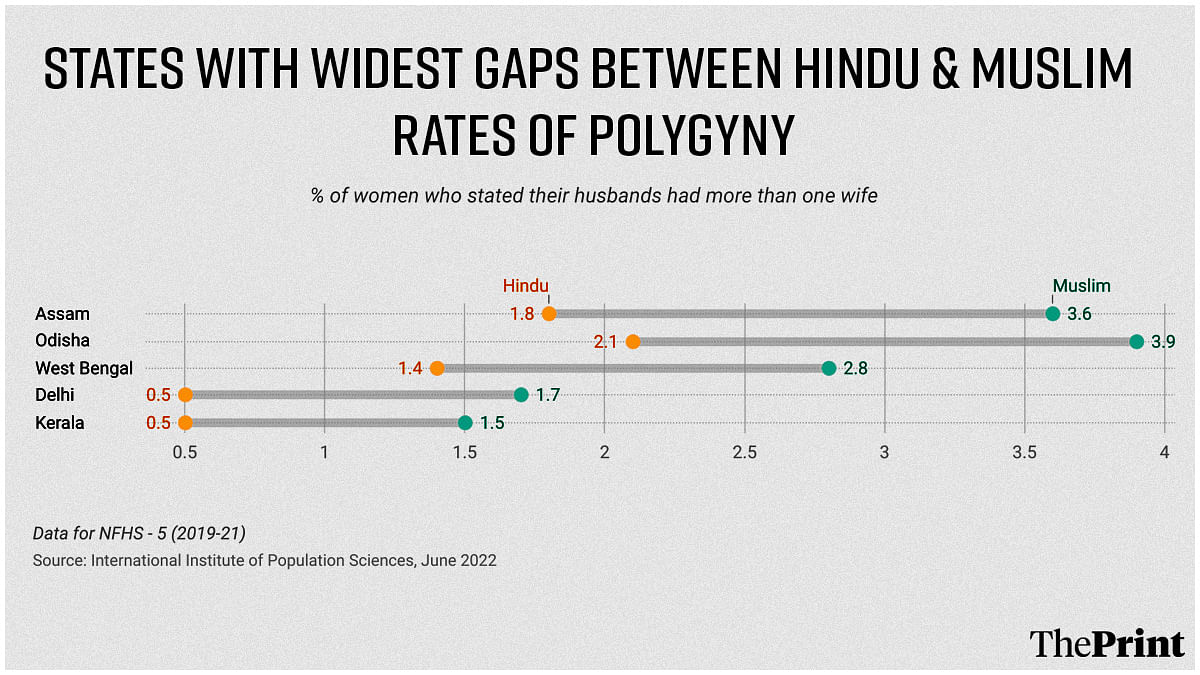
There were also four states where the proportion of Hindu women who admitted to living in a polygynous relationship was higher than that of Muslim women.
In Telangana, this was 3 per cent in the case of Hindu women as against 2.1 per cent in the case of Muslim women. Chhattisgarh (2 per cent vs 1.6 per cent), Tamil Nadu (2 per cent vs 1.7 per cent) and Andhra Pradesh (1.9 per cent vs 1.8 per cent) were the other three states that reported a similar pattern.
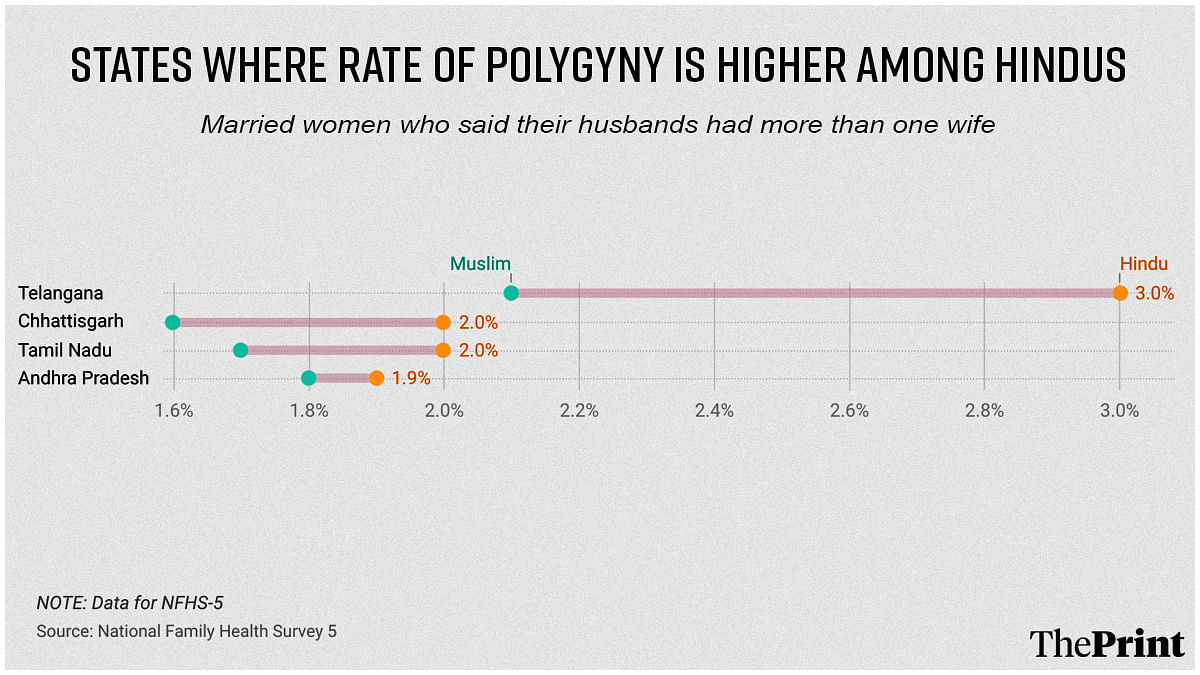
According to the brief, the practice of polygamy fades with improvement in income. Among the poorest households in India, the rate of polygamy was 2.4 per cent, as against 0.5 per cent among the richest households.
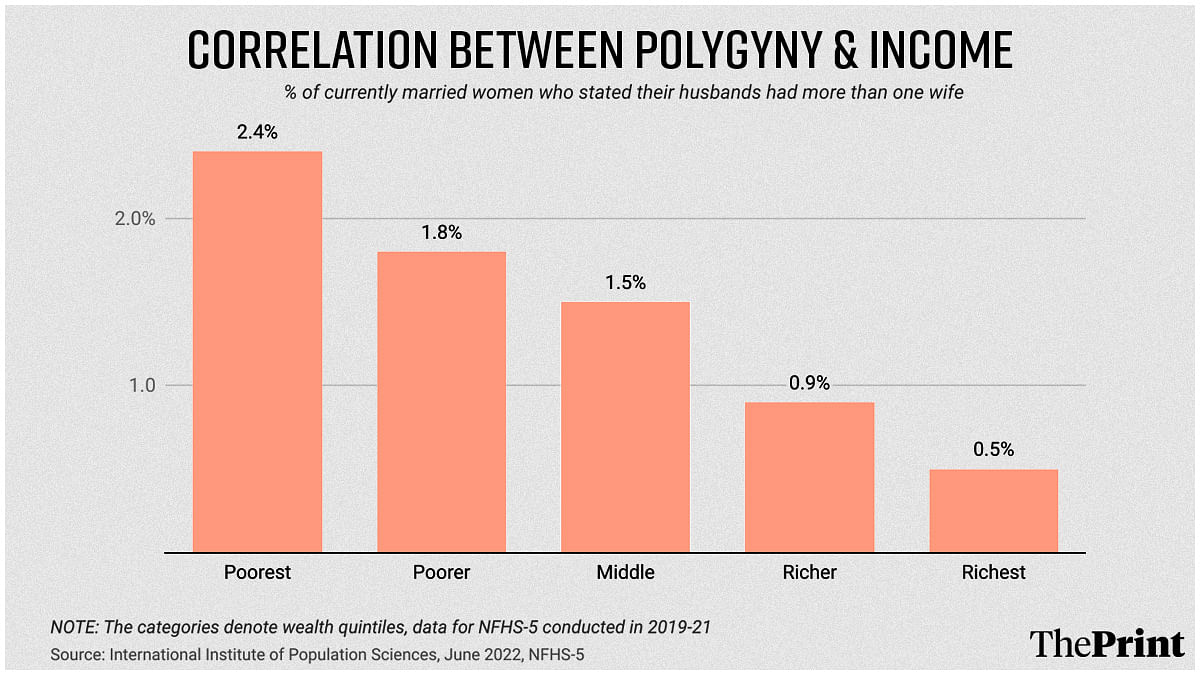
Polygamy & regional heterogeneity
In total, there were about 18 states and UTs where the prevalence of polygamy was above the national average of 1.4.
Meghalaya reported the highest figure for polygamy, with 6.1 per cent of women in the state admitting that their husbands had another wife or wives.
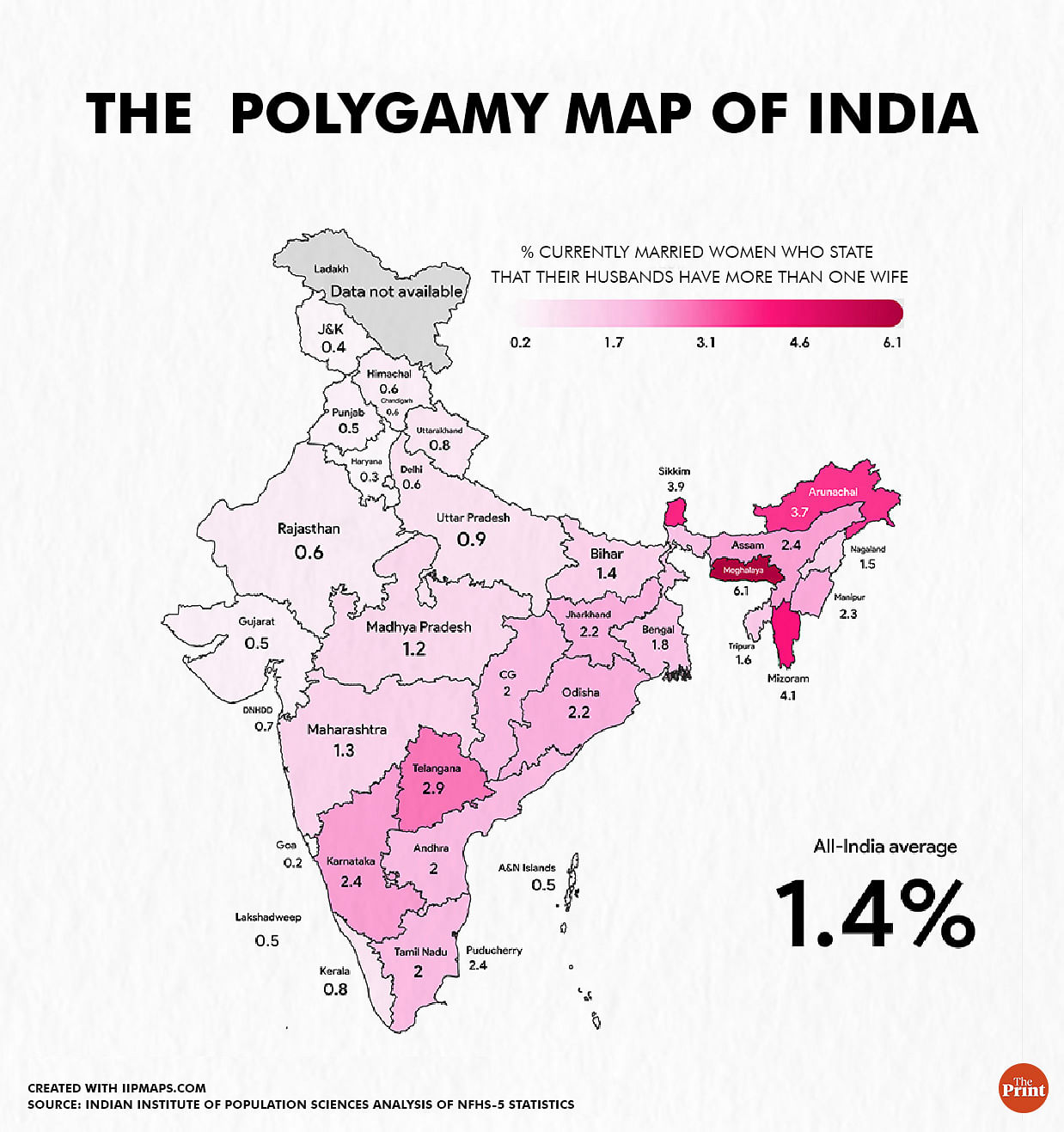
In Mizoram and Sikkim, where tribals make up 95 per cent and 33.8 per cent of the population respectively, the polygamy rates were 4.1 per cent and 3.9 per cent.
In Arunachal Pradesh, it was 3.7 per cent, followed by Telangana (2.9 per cent) and 2.4 per cent each in Assam, Karnataka, and Puducherry.
Goa had the lowest rate of polygamy — barely 0.2 per cent, or 1 in 500 women, said their husbands had more than one wife. Joining Goa at the bottom end of the list were Haryana (0.3 per cent), Jammu and Kashmir (0.4 per cent), Gujarat (0.5 per cent), Punjab (0.5 per cent) and Rajasthan, Delhi, and Himachal Pradesh (0.6 per cent each).
The research brief also lists out 40 districts where the prevalence of polygynous marriages was high, with East Jaintia Hills district in Meghalaya reporting the highest — nearly one in every five women surveyed in the district admitted to being in a polygynous marriage.
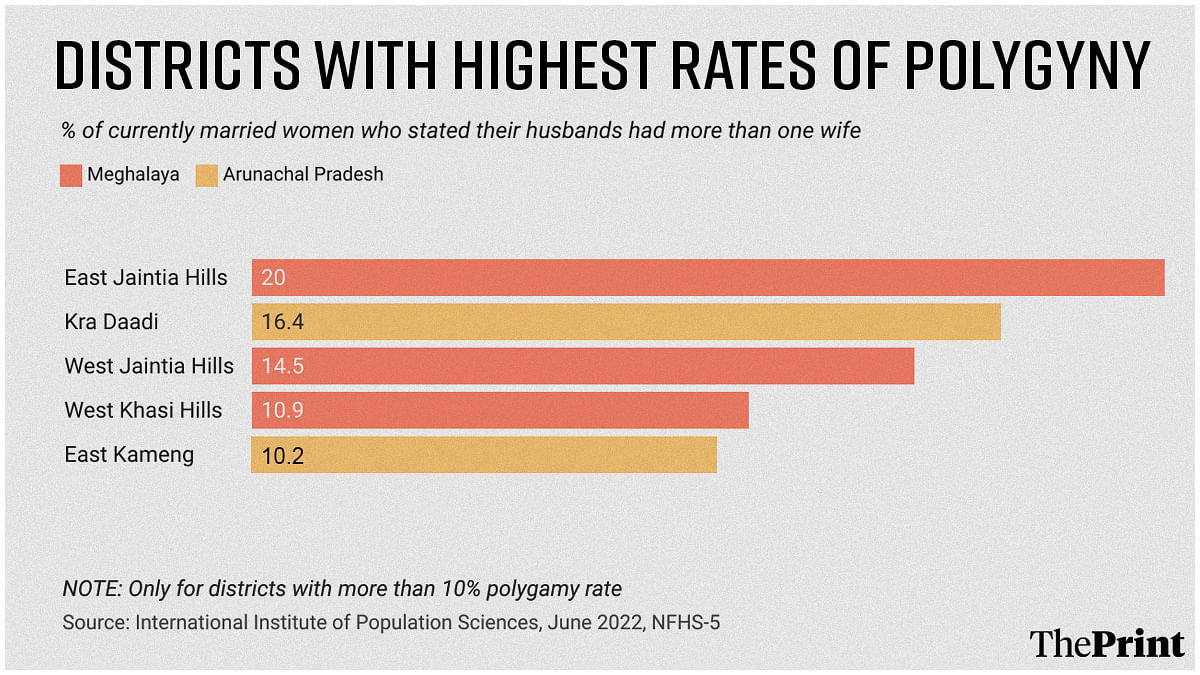
The rate of polygamy was 16.4 per cent in Arunachal Pradesh’s Kra Daadi district, followed by West Jaintia Hills in Meghalaya (14.5 per cent). West Khasi Hills in Meghalaya and East Kameng in Arunachal Pradesh also reported a rate of polygamy higher than 10 per cent.
The research brief also emphasises that policy makers working on this issue must know that this practice is low and further declining in India.
“Before arriving at any conclusion based on the social, economic and demographic characteristics, one has to bear in mind that the prevalence of polygyny in India is low and it is fading away,” it concludes, adding that the demographic health and gender consequences of polygyny need further investigation.
(Edited by Amrtansh Arora)
Also Read: Indians are growing fatter, and the problem is biggest for wealthy women, shows NFHS data


